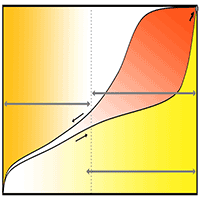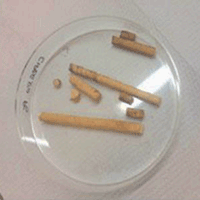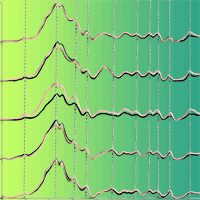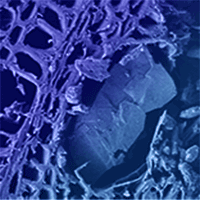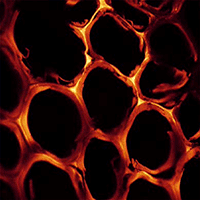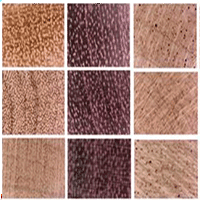Water plays an essential role in fungal decay of wood, and limiting the cell wall moisture content by chemical modification can effectively improve the durability of the material. Investigating the wood-water relations of modified material under climatic conditions relevant for fungal decay are, however, experimentally challenging. Most studies in literature therefore focus on moisture sorption under conditions outside those of importance for fungal decay. This review discusses the validity of such data for characterising the wood-water relations at very humid climatic conditions, relevant for fungal decay. Moreover, the review attempts to cover the basics of fungal decay, the important role of water, and how controlling water content by modification can improve durability.
Keywords
, , ,
Citation
Thybring EE, Kymäläinen M, Rautkari L (2018). Moisture in modified wood and its relevance for fungal decay. iForest 11: 418-422. - doi: 10.3832/ifor2406-011
Academic Editor
Giacomo Goli
Paper history
Received: Feb 13, 2017
Accepted: Mar 18, 2018
First online: Jun 05, 2018
Publication Date: Jun 30, 2018
Publication Time: 2.63 months
© SISEF - The Italian Society of Silviculture and Forest Ecology 2018
Open Access
This article is distributed under the terms of the Creative Commons Attribution-Non Commercial 4.0 International (https://creativecommons.org/licenses/by-nc/4.0/), which permits unrestricted use, distribution, and reproduction in any medium, provided you give appropriate credit to the original author(s) and the source, provide a link to the Creative Commons license, and indicate if changes were made.

Breakdown by View Type
(Waiting for server response...)
Article Usage
Total Article Views: 50649
(from publication date up to now)
Breakdown by View Type
HTML Page Views: 39740
Abstract Page Views: 4541
PDF Downloads: 5369
Citation/Reference Downloads: 12
XML Downloads: 987
Web Metrics
Days since publication: 2732
Overall contacts: 50649
Avg. contacts per week: 129.77
Article Citations
Article citations are based on data periodically collected from the Clarivate Web of Science web site
(last update: Mar 2025)
Total number of cites (since 2018): 35
Average cites per year: 4.38
Publication Metrics
by Dimensions ©
Articles citing this article
List of the papers citing this article based on CrossRef Cited-by.
(1)
Alfredsen G, Solheim H, Jenssen KM (2005)Evaluation of decay fungi in Norwegian buildings. IIn: Proceedings of the “International Research Group on Wood Protection”. Bangalore (India) 24-28 April 2005. Document IRG/WP 05-10562, IRG, Stockholm, Sweden, pp. 12.
Online |
Gscholar
(2)
Alfredsen G, Flaete PO, Militz H (2013)Decay resistance of acetic anhydride modified wood: a review. International Wood Products Journal 4: 137-143.
CrossRef |
Gscholar
(3)
Almeida G, Hernandez RE (2006)Changes in physical properties of yellow birch below and above the fiber saturation point. Wood and Fiber Science 38: 74-83.
CrossRef |
Gscholar
(4)
Almeida G, Hernandez RE (2007)Influence of the pore structure of wood on moisture desorption at high relative humidities. Wood Material Science and Engineering 2: 33-44.
CrossRef |
Gscholar
(5)
Ammer U (1963)Untersuchungen über die Sorption pilzbefallenen Holzes [Investigations of the sorption of fungally attacked wood]. Holz als Roh- und Werkstoff 21: 465-470. [in German]
CrossRef |
Gscholar
(6)
Ammer U (1964)Uber den Zusammenhang zwischen Holzfeuchtigkeit und Holzzerstörung durch Pilze [On the relationship between wood moisture content and wood decay by fungi]. Holz als Roh- und Werkstoff 22: 47-51. [in German]
Gscholar
(7)
Anagnost SE, Smith WB (1997)Hygroscopicity of decayed wood: Implications for weight loss determinations. Wood and Fiber Science 29: 299-305.
Gscholar
(8)
Arantes V, Milagres AMF (2007)The synergistic action of ligninolytic enzymes (MnP and Laccase) and Fe
3+-reducing activity from white-rot fungi for degradation of Azure B. Enzyme and Microbial Technology 42: 17-22.
CrossRef |
Gscholar
(9)
Arantes V, Milagres AMF, Filley TR, Goodell B (2011)Lignocellulosic polysaccharides and lignin degradation by wood decay fungi: the relevance of nonenzymatic Fenton-based reactions. Journal of Industrial Microbiology and Biotechnology 38: 541-555.
CrossRef |
Gscholar
(10)
Beckers EPJ, Militz H, Stevens M (1994)Resistance of acetylated wood to basidiomycetes, soft rot and blue stain. In: Proceedings of the “International Research Group on Wood Protection”. Bali (Indonesia) May 29-June 3 1994. Document IRG/WP 94-40021, IRG, Stockholm, Sweden, pp. 11.
Online |
Gscholar
(11)
Brelid PL, Westin M (2007)Acetylated wood - results from long-term field tests. In: Proceedings of the “3
rd European Conference on Wood Modification” (Hill CAS ed). Cardiff, Wales (UK) 15-16 Oct 2007. BioComposites Centre, Bangor, UK, pp. 71-78.
Gscholar
(12)
Brelid PL, Simonson R, Bergman O, Nilsson T (2000)Resistance of acetylated wood to biological degradation. Holz Als Roh-und Werkstoff 58: 331-337.
CrossRef |
Gscholar
(13)
Buro A (1954)Untersuchungen über den Abbau von Kiefern: und Buchenholz durch holzzerstörende Pilze und deren Einfluß auf einige physikalische Eigenschaften des Holzes [Investigations of the decomposition of pine and beech by wood-decaying fungi and the influence on some physical wood properties]. Holz als Roh- und Werkstoff 12: 258-267. [in German]
CrossRef |
Gscholar
(14)
Cardias MFC (1992)The protection of wood against fungal decay by isocyanate chemical modification. PhD thesis, University of Wales, Bangor, UK, pp. 243.
Gscholar
(15)
Clarke RW, Jennings DH, Coggins CR (1980)Growth of
Serpula lacrimans in relation to water potential of substrate. Transactions of the British Mycological Society 75: 271-280.
CrossRef |
Gscholar
(16)
Clausen CA, Glass SV (2012)Build green: wood can last for centuries. Report no. FPL-GTR-215, Forest Products Laboratory, USDA Forest Service, Madison, WI, USA, pp. 24.
Gscholar
(17)
Cloutier A, Fortin Y (1991)Moisture-content - water potential relationship of wood from saturated to dry conditions. Wood Science and Technology 25: 263-280.
CrossRef |
Gscholar
(18)
Cragg SM, Beckham GT, Bruce NC, Bugg TDH, Distel DL, Dupree P, Etxabe AG, Goodell BS, Jellison J, McGeehan JE, McQueen-Mason SJ, Schnorr K, Walton PH, Watts JEM, Zimmer M (2015)Lignocellulose degradation mechanisms across the tree of life. Current Opinion in Chemical Biology 29: 108-119.
CrossRef |
Gscholar
(19)
Daniel G, Nilsson T, Pettersson B (1989)Intracellular and extracellular localization of lignin peroxidase during the degradation of solid wood and wood fragments by
Phanerochaete chrysosporium by using transmission electron-microscopy and immuno-gold labeling. Applied and Environmental Microbiology 55: 871-881.
Gscholar
(20)
Daniel G, Pettersson B, Nilsson T, Volc J (1990)Use of immunogold cytochemistry to detect Mn(II)-dependent and lignin peroxidases in wood degraded by the white rot fungi
Phanerochaete chrysosporium and
Lentinula edodes. Canadian Journal of Botany 68: 920-933.
CrossRef |
Gscholar
(21)
Daniel G, Volc J, Niku-Paavola ML (2004)Cryo-FE-SEM and TEM immuno-techniques reveal new details for understanding white-rot decay of lignocellulose. Comptes Rendus Biologies 327: 861-871.
CrossRef |
Gscholar
(22)
Duncan CG, Lombard FF (1965)Fungi associated with principal decays in wood products in the United States. US Department of Agriculture, Washington, DC, USA, pp. 31.
CrossRef |
Gscholar
(23)
Engelund ET, Thygesen LG, Hoffmeyer P (2010)Water sorption in wood and modified wood at high values of relative humidity. Part 2: Appendix. Theoretical assessment of the amount of capillary water in wood microvoids. Holzforschung 64: 325-330.
CrossRef |
Gscholar
(24)
Engelund ET, Thygesen LG, Svensson S, Hill CAS (2013)A critical discussion of the physics of wood-water interactions. Wood Science and Technology 47: 141-161.
CrossRef |
Gscholar
(25)
Farahani MRM (2003)Decay resistance of modified wood. PhD thesis, University of Wales, Bangor, UK, pp. 279.
Gscholar
(26)
Forster S (1998)The decay resistance of chemically modified softwood. PhD thesis, University of Wales, Bangor, UK, pp. 252.
Gscholar
(27)
Fortin Y (1979)Moisture content-matric potential relationship and water flow properties of wood at high moisture contents. PhD thesis, University of British Columbia, Vancouver, Canada, pp. 187.
Gscholar
(28)
Fredriksson M, Johansson P (2016)A method for determination of absorption isotherms at high relative humidity levels: measurements on lime-silica brick and Norway spruce (
Picea abies (L.) Karst.). Drying Technology 34: 132-141.
CrossRef |
Gscholar
(29)
Fredriksson M, Wadsö L, Johansson P (2013)Small resistive wood moisture sensors: a method for moisture content determination in wood structures. European Journal of Wood and Wood Products 71: 515-524.
CrossRef |
Gscholar
(30)
Goodell B, Jellison J, Liu J, Daniel G, Paszczynski A, Fekete F, Krishnamurthy S, Jun L, Xu G (1997)Low molecular weight chelators and phenolic compounds isolated from wood decay fungi and their role in the fungal biodegradation of wood. Journal of Biotechnology 53: 133-162.
CrossRef |
Gscholar
(31)
Grethlein HE (1985)The effect of pore size distribution on the rate of enzymatic hydrolysis of cellulosic substrates. Nature Biotechnology 3: 155-160.
CrossRef |
Gscholar
(32)
Grethlein HE, Allen DC, Converse AO (1984)A comparative study of the enzymatic hydrolysis of acid-pretreated white pine and mixed hardwood. Biotechnology and Bioengineering 26: 1498-1505.
CrossRef |
Gscholar
(33)
Griffin DM (1977)Water potential and wood-decay fungi. Annual Review of Phytopathology 15: 319-329.
CrossRef |
Gscholar
(34)
Halliwell B (2003)Free radical chemistry as related to degradative mechanisms. In: “Wood Deterioration and Preservation” (Nicholas DD, Shcultz TP, Goodell B eds). American Chemical Society, Washington, DC, USA, pp. 10-15. -
Online |
Gscholar
(35)
Hastrup ACS, Jensen TO, Jensen B (2013)Detection of iron-chelating and iron-reducing compounds in four brown rot fungi. Holzforschung 67: 99-106.
CrossRef |
Gscholar
(36)
Hill CAS (2006)The use of timber in the twenty-first century. In: “Wood Modification: Chemical, Thermal and Other Processes” (Hill CAS ed). John Wiley and Sons Ltd, Chichester, UK, pp. 1-18.
Gscholar
(37)
Hill CAS, Hale MD, Ormondroyd GA, Kwon JH, Forster SC (2006)Decay resistance of anhydride-modified Corsican pine sapwood exposed to the brown rot fungus
Coniophora puteana. Holzforschung 60: 625-629.
CrossRef |
Gscholar
(38)
Hill CAS, Curling SF, Kwon JH, Marty V (2009)Decay resistance of acetylated and hexanoylated hardwood and softwood species exposed to
Coniophora puteana. Holzforschung 63: 619-625.
CrossRef |
Gscholar
(39)
Hoffmann K (1910)Wachstumsverhältnisse einiger holzzerstörenden Pilze [Growth conditions for some wood-decaying fungi]. Zeitschrift für die gesammten Naturwissenschaften 82: 35-128. [in German]
Gscholar
(40)
Hori C, Gaskell J, Igarashi K, Samejima M, Hibbett D, Henrissat B, Cullen D (2013)Genomewide analysis of polysaccharides degrading enzymes in 11 white- and brown-rot Polyporales provides insight into mechanisms of wood decay. Mycologia 105: 1412-1427.
CrossRef |
Gscholar
(41)
Hosseinpourpia R, Mai C (2016a)Mode of action of brown rot decay resistance in phenol-formaldehyde-modified wood: resistance to Fenton’s reagent. Holzforschung 70: 253-259.
CrossRef |
Gscholar
(42)
Hosseinpourpia R, Mai C (2016b)Mode of action of brown rot decay resistance of acetylated wood: resistance to Fenton’s reagent. Wood Science and Technology 50: 413-426.
CrossRef |
Gscholar
(43)
Hosseinpourpia R, Mai C (2016c)Mode of action of brown rot decay resistance of thermally modified wood: resistance to Fenton’s reagent. Holzforschung 70: 691-697.
CrossRef |
Gscholar
(44)
Jakes JE, Plaza N, Stone DS, Hunt CG, Glass SV, Zelinka SL (2013)Mechanism of transport through wood cell wall polymers. Journal of Forest Products and Industries 2: 10-13.
Gscholar
(45)
Kamdem DP, Pizzi A, Jermannaud A (2002)Durability of heat-treated wood. Holz Als Roh-und Werkstoff 60: 1-6.
CrossRef |
Gscholar
(46)
Kirk TK, Cowling EB (1984)Biological decomposition of solid wood. In: “The chemistry of solid wood” (Rowell RM ed). American Chemical Society, Washington, DC, USA, pp. 455-487. -
Online |
Gscholar
(47)
Kirker G, Zelinka S, Gleber SC, Vine D, Finney L, Chen S, Hong YP, Uyarte O, Vogt S, Jellison J, Goodell B, Jakes JE (2017)Synchrotron-based X-ray fluorescence microscopy enables multiscale spatial visualization of ions involved in fungal lignocellulose deconstruction. Scientific Reports 7: 41798.
CrossRef |
Gscholar
(48)
Kumar S, Agarwal SC (1983)Biological degradation resistance of wood acetylated with thioacetic acid. In: Proceedings of the “International Research Group on Wood Protection”. Surfers Paradise, QLD (Australia) 9-13 May 1983. Document IRG/WP 83-3223, IRG, Stockholm, Sweden, pp. 13.
Gscholar
(49)
Kymäläinen M, Havimo M, Louhelainen J (2014)Sorption properties of torrefied wood and charcoal. Wood Material Science and Engineering 9: 170-178.
CrossRef |
Gscholar
(50)
Kymäläinen M, Mäkelä MR, Hildén K, Kukkonen J (2015)Fungal colonisation and moisture uptake of torrefied wood, charcoal, and thermally treated pellets during storage. European Journal of Wood and Wood Products 73: 709-717.
CrossRef |
Gscholar
(51)
Lehmann KB, Scheible E (1923)Quantitative Untersuchung über Holzzerstörung durch Pilze [Quantitative investigation of wood decay by fungi]. Archiv für Hygiene 92: 89-108. [in German]
Gscholar
(52)
Levi M (1973)Control methods. In: “Wood deterioration and its prevention by preservative treatments” (Nicholas DD ed). Vol. 1, chap. 5. Syracuse University Press, Syracuse, NY, USA, pp. 183-216.
Gscholar
(53)
Mez C (1908)Der Hausschwamm und die übrigen holzzerstörenden Pilze der menschlichen Wohnungen [The dry rot fungus and the other wood-decaying fungi in human homes]. Richard Lincke, Dresden, Germany, pp. 191-192. [in German]
Gscholar
(54)
Mohebby B (2003)Biological attack of acetylated wood. PhD thesis, Georg-August-Universität Göttingen, Göttingen, Germany, pp. 147.
Gscholar
(55)
Ormondroyd GA, Alfredsen G, Prabhakaran RTD, Curling SF, Stefanowski BK, Spear MJ, Gobakken LR (2017)Assessment of the use of dynamic mechanical analysis to investigate initial onset of brown rot decay of Scots pine (
Pinus sylvestris L.). International Biodeterioration and Biodegradation 120: 1-5.
CrossRef |
Gscholar
(56)
Papadopoulos AN, Hill CAS (2002)The biological effectiveness of wood modified with linear chain carboxylic acid anhydrides against Coniophora puteana. Holz Als Roh-und Werkstoff 60: 329-332.
CrossRef |
Gscholar
(57)
Papadopoulos AN (2006)Decay resistance in ground stake test of acetylated OSB. Holz Als Roh-und Werkstoff 64: 245-246.
CrossRef |
Gscholar
(58)
Peterson CA, Cowling EB (1973)Influence of various initial moisture contents on decay of Sitka spruce and sweetgum sapwood by
Polyporus versicolor in the soil-block test. Phytopathology 63: 235-237.
CrossRef |
Gscholar
(59)
Peterson MD, Thomas RJ (1978)Protection of wood from decay fungi by acetylation - an ultrastructural and chemical study. Wood and Fiber Science 10: 149-163.
Gscholar
(60)
Riley R, Salamov AA, Brown DW, Nagy LG, Floudas D, Held BW, Levasseur A, Lombard V, Morin E, Otillar R, Lindquist EA, Sun H, LaButti KM, Schmutz J, Jabbour D, Luo H, Baker SE, Pisabarro AG, Walton JD, Blanchette RA, Henrissat B, Martin F, Cullen D, Hibbett DS, Grigoriev IV (2014)Extensive sampling of basidiomycete genomes demonstrates inadequacy of the white-rot/brown-rot paradigm for wood decay fungi. Proceedings of the National Academy of Sciences USA 111: 9923-9928.
CrossRef |
Gscholar
(61)
Ringman R, Pilgård A, Brischke C, Richter K (2014a)Mode of action of brown rot decay resistance in modified wood: a review. Holzforschung 68: 239-246.
CrossRef |
Gscholar
(62)
Ringman R, Pilgård A, Richter K (2014b)Effect of wood modification on gene expression during incipient
Postia placenta decay. International Biodeterioration and Biodegradation 86 Part B: 86-91.
CrossRef |
Gscholar
(63)
Ringman R, Pilgård A, Brischke C, Windeisen E, Richter K (2017)Incipient brown rot decay in modified wood: patterns of mass loss, structural integrity, moisture and acetyl content in high resolution. International Wood Products Journal 8: 172-182.
CrossRef |
Gscholar
(64)
Schilling JS, Duncan SM, Presley GN, Filley TR, Jurgens JA, Blanchette RA (2013)Colocalizing incipient reactions in wood degraded by the brown rot fungus
Postia placenta. International Biodeterioration and Biodegradation 83: 56-62.
CrossRef |
Gscholar
(65)
Schmidt O (2007)Indoor wood-decay basidiomycetes: damage, causal fungi, physiology, identification and characterization, prevention and control. Mycological Progress 6: 261-279.
CrossRef |
Gscholar
(66)
Schultze-Dewitz G, Lenhart K, Peschka F (1969)Das Sorptionsverhalten des Holzes verschiedener Kiefernarten und der Fichte nach Angriff durch Braunfäulepilze (Basidiomyceten) [The sorption relations of wood of different pine species and spruce after attack by brown-rot fungi (basidiomycetes)]. Holztechnologie 10: 113-118. [in German]
Gscholar
(67)
Srebotnik E, Messner K, Foisner R (1988)Penetrability of white rot-degraded pine wood by the lignin peroxidase of
Phanerochaete chrysosporium. Applied and Environmental Microbiology 54: 2608-2614.
Online |
Gscholar
(68)
Stone JE, Scallan AM (1967)Effect of component removal upon porous structure of cell wall of wood. 2. Swelling in water and fiber saturation point. Tappi 50: 496-501.
Gscholar
(69)
Takahashi M, Imamura Y, Tanahashi M (1989)Effect of acetylation on decay resistance of wood against brown-rot, white-rot and soft-rot fungi. In: Proceedings of the “International Research Group on Wood Protection”. Lappeenranta (Finland) 22-26 May 1989. Document IRG/WP 89-3540, IRG, Stockholm, Sweden, pp. 16.
Gscholar
(70)
Thybring EE (2013)The decay resistance of modified wood influenced by moisture exclusion and swelling reduction. International Biodeterioration and Biodegradation 82: 87-95.
CrossRef |
Gscholar
(71)
Thybring EE (2017)Water relations in untreated and modified wood under brown-rot and white-rot decay. International Biodeterioration and Biodegradation 118: 134-142.
CrossRef |
Gscholar
(72)
Thygesen LG, Engelund ET, Hoffmeyer P (2010)Water sorption in wood and modified wood at high values of relative humidity. Part I: Results for untreated, acetylated, and furfurylated Norway spruce. Holzforschung 64: 315-323.
CrossRef |
Gscholar
(73)
Vaaje-Kolstad G, Westereng B, Horn SJ, Liu Z, Zhai H, Sørlie M, Eijsink VGH (2010)An oxidative enzyme boosting the enzymatic conversion of recalcitrant polysaccharides. Science 330: 219-222.
CrossRef |
Gscholar
(74)
Viitanen H, Ritschkoff AC (1991)Brown rot decay in wooden constructions - effect of temperature, humidity and moisture. Swedish University of Agricultural Sciences, Uppsala, Sweden, pp. 55.
Gscholar
(75)
Viitanen HA (1997)Modelling the time factor in the development of brown rot decay in pine and spruce sapwood - the effect of critical humidity and temperature conditions. Holzforschung 51: 99-106.
CrossRef |
Gscholar
(76)
Weigl J, Ziegler H (1960)Wasserhaushalt und Stoffleitung bei
Merulius lacrymans (Wulf.) Fr [Water balance and matter transport in
Merulius lacrymans (Wulf.) Fr]. Archiv für Mikrobiologie 37: 124-133. [in German]
CrossRef |
Gscholar
(77)
Welzbacher CR, Rapp AO (2007)Durability of thermally modified timber from industrial-scale processes in different use classes: Results from laboratory and field tests. Wood Material Science and Engineering 2: 4-14.
CrossRef |
Gscholar
(78)
Williams FC, Hale MD (2003)The resistance of wood chemically modified with isocyanates: the role of moisture content in decay suppression. International Biodeterioration and Biodegradation 52: 215-221.
CrossRef |
Gscholar
(79)
Winandy JE, Morrell JJ (1993)Relationship between incipient decay, strength, and chemical-composition of Douglas-fir heartwood. Wood and Fiber Science 25: 278-288.
Online |
Gscholar
(80)
Wong KKY, Deverell KF, Mackie KL, Clark TA, Donaldson LA (1988)The relationship between fiber porosity and cellulose digestibility in steam-exploded
Pinus radiata. Biotechnology and Bioengineering 31: 447-456.
CrossRef |
Gscholar
(81)
Xu G, Goodell B (2001)Mechanisms of wood degradation by brown-rot fungi: chelator-mediated cellulose degradation and binding of iron by cellulose. Journal of Biotechnology 87: 43-57.
CrossRef |
Gscholar
(82)
Zauer M, Meissner F, Plagge R, Wagenführ A (2016)Capillary pore-size distribution and equilibrium moisture content of wood determined by means of pressure plate technique. Holzforschung 70: 137-143.
CrossRef |
Gscholar
(83)
Zelinka SL, Glass SV (2010)Water vapor sorption isotherms for Southern pine treated with several waterborne preservatives. Journal of Testing and Evaluation 38: 521-525.
Gscholar
(84)
Zelinka SL, Glass SV, Stone DS (2008)A percolation model for electrical conduction in wood with implications for wood-water relations. Wood and Fiber Science 40: 544-552.
Online |
Gscholar
(85)
Zelinka SL, Gleber SC, Vogt S, Rodríguez López GM, Jakes JE (2015)Threshold for ion movements in wood cell walls below fiber saturation observed by X-ray fluorescence microscopy (XFM). Holzforschung 69: 441-448.
CrossRef |
Gscholar
(86)
Zelinka SL, Glass SV, Boardman CR, Derome D (2016a)Moisture storage and transport properties of preservative treated and untreated southern pine wood. Wood Material Science and Engineering 11: 228-238.
CrossRef |
Gscholar
(87)
Zelinka SL, Ringman R, Pilgård A, Thybring EE, Jakes JE, Richter K (2016b)The role of chemical transport in the brown-rot decay resistance of modified wood. International Wood Products Journal 7: 66-70.
CrossRef |
Gscholar
(88)
Zeller SM (1920)Humidity in relation to moisture imbibition by wood and to spore germination on wood. Annals of the Missouri Botanical Garden 7: 51-74.
CrossRef |
Gscholar
(89)
Zhang J, Presley GN, Hammel KE, Ryu JS, Menke JR, Figueroa M, Hu D, Orr G, Schilling JS (2016)Localizing gene regulation reveals a staggered wood decay mechanism for the brown rot fungus
Postia placenta. Proceedings of the National Academy of Sciences USA 113: 10968-10973.
CrossRef |
Gscholar
